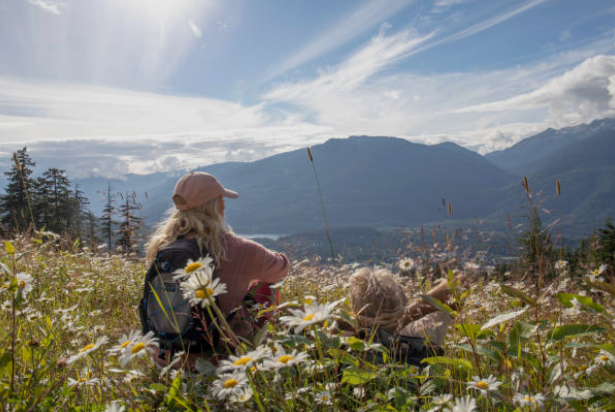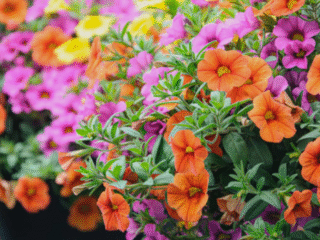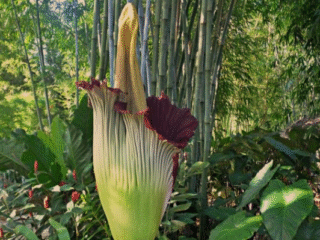Top 6 Breathtaking Wildflower Hikes Across America.
Hiking is a favorite activity in the United States, with over 30 million people hitting the trails yearly.
Many are drawn to wildflower hikes because of their vibrant colors and life.
America’s diverse landscapes offer many hiking trails that are breathtaking during wildflower season.
Whether you’re an experienced hiker or new to it, there’s a trail for you.
It’s sure to leave you in awe.
Let’s explore the USA’s most spectacular hiking trails.
We’ll take you on a journey through stunning wildflower displays across the country.
We’ll highlight the best routes for an unforgettable experience.
The Magic of Wildflower Hiking in America
Wildflower hiking is magical because it lets us see America’s natural beauty change.
Hikers walk through different landscapes and see colors that shift with the seasons.
Why Wildflower Hikes Are Worth the Journey
Wildflower hikes are more than pretty views.
They let us dive deep into nature. Surrounded by flowers, we find peace.
The trails challenge us but reward us with amazing sights and wildlife.
Wildflower Seasons and Bloom Patterns
To enjoy wildflower hikes, knowing when and where to go is key.
America’s wildflowers bloom at different times. This depends on the weather, soil, and how high up we are.
Wildflower Bloom Prediction Resources
For the best wildflower hikes, use online tools to plan.
Websites and apps give the latest on when and where to see wildflowers.
This helps us catch the blooms at their peak.
| Region | Peak Bloom Season | Common Wildflowers |
|---|---|---|
| Pacific Northwest | Late Spring to Early Summer | Oregon Sunshine, Lupine |
| Southwest Desert | Early Spring | Desert Marigold, Globemallow |
| Appalachian Mountains | Late Spring | Rhododendron, Violets |
Planning Your Wildflower Hiking Adventure
Planning a wildflower hike is key to a great trip.
You need the right gear, know how to take photos, and respect the flowers.
This way, you can enjoy the beauty without harming it.
Essential Gear for Wildflower Hiking
Choosing the right gear is important for a good hike.
Comfortable hiking boots and breathable clothing help you move and stay cool.
A field guide for wildflowers, a map, and a compass or GPS make your trip better.
Don’t forget sunscreen, insect repellent, and lots of water.
A camera is essential for capturing the wildflowers’ beauty.
Wildflower Photography Tips
Photography needs patience and basic knowledge.
Natural light is best in the morning or late afternoon.
A macro lens helps show the flowers’ details.
Try different angles and compositions for interesting photos.
Always be gentle with the flowers and their environment.
Leave No Trace: Ethical Wildflower Viewing
It’s important to view wildflowers ethically.
The Leave No Trace rule means staying on trails, not picking flowers, and not littering.
Wildflower Conservation Guidelines
Knowing local rules helps protect wildflowers.
This includes knowing about protected areas and rare species.
- Stay on marked trails to avoid damaging habitats.
- Refrain from picking or trampling wildflowers.
- Be mindful of sensitive ecosystems.
Top 6 Breathtaking Wildflower Hikes Across America: Pacific Northwest Region
The Pacific Northwest is a wildflower paradise.
Its mild climate, varied terrain, and plenty of rain make it perfect for wildflowers.
This creates a stunning environment for hikers to explore.
Dog Mountain Trail, Columbia River Gorge, Washington
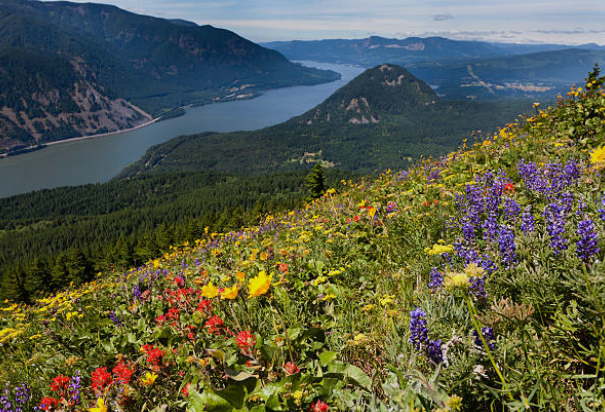
The Dog Mountain Trail in the Columbia River Gorge is loved by many.
It’s known for its challenging ascent and breathtaking views of the gorge.
Trail Details and Difficulty
The trail is about 6.5 miles round trip, with an elevation gain of 2,700 feet.
It’s considered moderately difficult because of its steep climb.
Best Viewing Months
The best time for wildflowers on Dog Mountain is late April to early July.
The peak bloom is usually in May and June.
Iron Mountain Trail, Willamette National Forest, Oregon

The Iron Mountain Trail in the Willamette National Forest is a gem.
It offers a diverse array of wildflowers and beautiful views.
The trail is known for its gentle slope.
The trail is about 9.5 miles round trip, with an elevation gain of 2,300 feet.
It’s a moderate hike that most hikers can handle.
Skyline Trail, Mount Rainier National Park, Washington
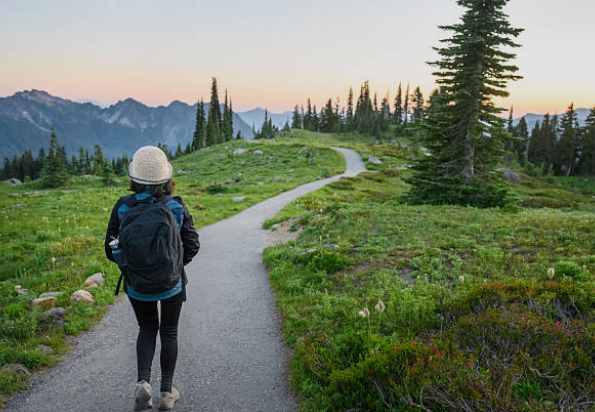
Skyline Trail, Mount Rainier National Park, Washington

The Skyline Trail at Mount Rainier National Park is a must-visit for wildflower lovers.
It has stunning views and a variety of alpine wildflowers.
The Skyline Trail is about 5 miles round trip. Its difficulty varies due to high elevation and snow.
The best months for viewing are July and August.
1) California’s Premier Wildflower Destinations
California is a paradise for wildflower lovers.
Its varied landscapes, from deserts to mountains and coastlines, are home to many wildflowers.
This diversity makes it a perfect place to see stunning wildflower displays.
Antelope Valley California Poppy Reserve, Lancaster
The Antelope Valley California Poppy Reserve is a top spot for wildflower fans.
Located in Lancaster, it’s known for its bright California poppies.
Poppy Viewing Tips
- Visit during peak bloom season, typically from March to May
- Take the self-guided driving tour to explore the reserve
- Bring a camera to capture the stunning displays
Chimney Creek, Sierra Nevada Mountains
Chimney Creek, in the Sierra Nevada Mountains, offers a peaceful wildflower experience.
It’s famous for its green meadows and many wildflower types.
Point Reyes National Seashore Trails
Point Reyes National Seashore is perfect for those who love coastal wildflowers.
The trails give you amazing views of the Pacific Ocean and a variety of wildflowers.
Coastal Wildflower Species
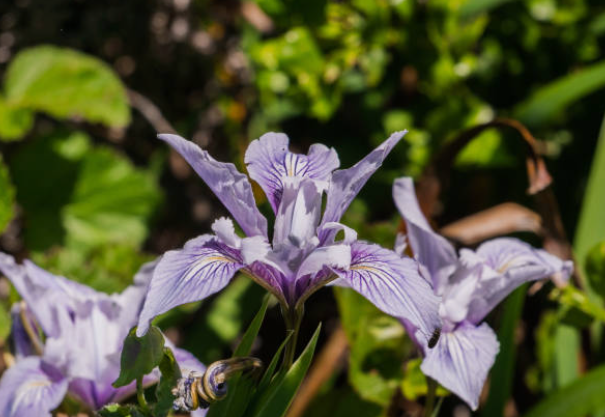
Some common coastal wildflowers in Point Reyes include:
| Wildflower Species | Blooming Period | Color |
|---|---|---|
| Douglas Iris | March-May | Purple |
| Coastal Pansy | February-April | Yellow, Purple |
| California Poppy | March-May | Orange |
2) Rocky Mountain Wildflower Spectacles
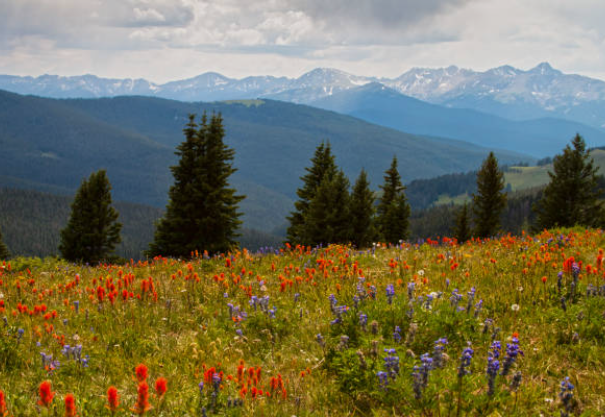
Summer brings a burst of colors to the Rocky Mountains.
This area is known for its stunning wildflower displays. People from all over come to see them.
The Rocky Mountains have a wide variety of wildflowers.
This is because of their large size and different climates.
From Colorado’s green meadows to Utah’s rocky peaks, it’s a dream spot for wildflower lovers.
Crested Butte Wildflower Trails, Colorado
Crested Butte is called the wildflower capital of Colorado.
It’s surrounded by trails with amazing wildflower views.
You’ll see columbines, lupines, and sunflowers.
The Wildflower Capital of Colorado
Crested Butte’s special geography and climate make it perfect for wildflowers.
It has over 200 species.
It’s a top spot for anyone wanting to see the Rocky Mountain wildflowers.
Yankee Boy Basin, San Juan Mountains, Colorado
Yankee Boy Basin is a beautiful place for wildflowers.
It’s surrounded by high peaks and has trails for all hikers.
- Enjoy breathtaking views of wildflowers, including gentians and alpine sunflowers.
- Explore the basin’s scenic trails, ranging from easy to challenging.
- Experience the unique geology and diverse wildlife of the San Juan Mountains.
Albion Basin, Little Cottonwood Canyon, Utah
Albion Basin is a beautiful meadow with granite peaks.
It’s a peaceful place for wildflower lovers.
Alpine Meadow Flowers
The basin has many alpine meadow flowers.
You’ll see alpine forget-me-nots and sky pilot.
Hiking through the meadows is a great way to explore.
In conclusion, the Rocky Mountains offer an unforgettable wildflower experience.
Places like Crested Butte, Yankee Boy Basin, and Albion Basin show the region’s beauty.
3) Southwest Desert Bloom Experiences
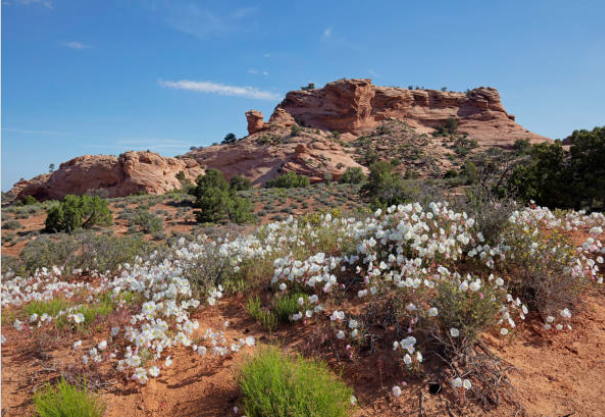
The Southwest desert turns into a colorful paradise during wildflower season.
It’s a special treat for nature lovers and hikers.
The desert, known for being dry, comes alive with vibrant colors from different wildflowers.
Anza-Borrego Desert State Park, California
Anza-Borrego Desert State Park in California is a top spot for the super bloom.
This huge desert park is full of different plants.
You’ll see the famous California poppy and many cacti.
Super Bloom Phenomena
The super bloom is a rare and amazing event.
It happens when lots of rain cause wildflowers to bloom everywhere. Anza-Borrego is famous for these events, drawing visitors from all over.
Picacho Peak State Park, Arizona
Picacho Peak State Park in Arizona is another great place for wildflowers.
The trails take you through different desert areas.
You’ll see lupines and Mexican gold poppies along the way.
Chihuahuan Desert Trails, Big Bend National Park, Texas
Big Bend National Park in Texas is perfect for exploring the Chihuahuan Desert’s wildflowers.
The trails offer beautiful views of the desert with wildflowers like bluebonnets and prickly pear cactus flowers.
Desert Wildflower Adaptations
Desert wildflowers have special ways to survive the harsh desert.
They have deep roots to find water deep underground. They can also stay dormant when it’s dry.
| Park/Location | Notable Wildflowers | Best Time to Visit |
|---|---|---|
| Anza-Borrego Desert State Park, CA | California Poppy, Desert Marigold | March to May |
| Picacho Peak State Park, AZ | Lupine, Mexican Gold Poppy | February to April |
| Big Bend National Park, TX | Bluebonnet, Prickly Pear Cactus Flower | March to May |
4) Appalachian and Blue Ridge Mountain Wildflower Trails
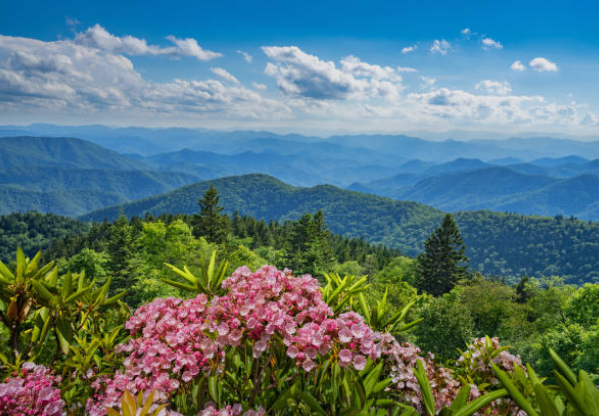
From spring to fall, the Appalachian and Blue Ridge Mountains are a colorful sight.
They are full of wildflowers, making them perfect for hikers.
The area’s different landscapes and weather support many types of plants.
Walking these trails is more than just seeing pretty views.
It’s a deep dive into nature.
You’ll see everything from the tiny Trillium to the bright azaleas and rhododendrons.
Craggy Gardens Trail, Blue Ridge Parkway, North Carolina
The Craggy Gardens Trail is a top spot for wildflower fans.
It’s along the Blue Ridge Parkway in North Carolina.
In mid-summer, the trail is covered in rhododendrons, turning it into a sea of pink and purple.
The trail is a 1.5-mile loop that’s not too hard.
It goes through gardens and offers great views. It’s easy enough for many hikers to enjoy.
Gregory Bald, Great Smoky Mountains National Park
Gregory Bald is a famous peak in the Great Smoky Mountains National Park.
It’s known for its flame azaleas.
The bald’s grassy top, surrounded by dense woods, is home to many wildflowers.
Famous Azalea Displays
The flame azaleas at Gregory Bald bloom in late June.
This creates a stunning display of color.
It draws visitors from all over, making it a key event in the park’s year.
Shenandoah National Park Trails, Virginia
Shenandoah National Park has many trails that show off Appalachian wildflowers.
Trails like the Stony Man Trail and the Dark Hollow Trail let hikers see the park’s plants.
The park’s different landscapes support many wildflowers.
You can see black cohosh, golden ragwort, and violets.
The park’s trails offer a chance to see these plants up close, each one showing a different side of the region’s plants.
| Trail Name | Location | Notable Wildflowers |
|---|---|---|
| Craggy Gardens Trail | Blue Ridge Parkway, North Carolina | Rhododendrons |
| Gregory Bald | Great Smoky Mountains National Park | Flame Azaleas |
| Stony Man Trail | Shenandoah National Park, Virginia | Black Cohosh, Violets |
5) Midwest Prairie Wildflower Experiences
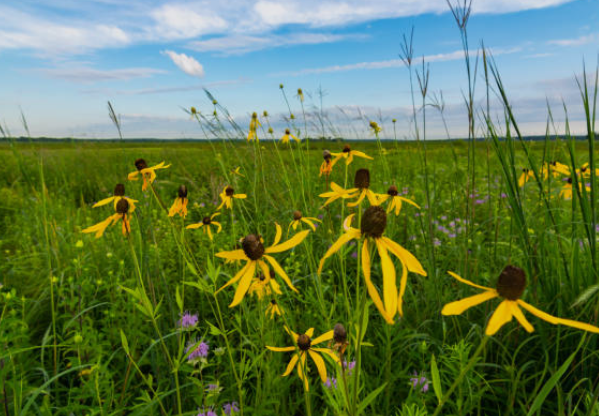
The tallgrass prairies in the Midwest are known for their stunning wildflowers.
These open spaces are filled with a variety of plants, making a colorful scene that changes with the seasons.
Konza Prairie, Kansas
Konza Prairie is a top spot for wildflower lovers.
It’s a protected area with a tallgrass prairie ecosystem.
This ecosystem is home to many plants and animals.
Tallgrass Prairie Ecosystem
The tallgrass prairie has many plant species, like big bluestem and switchgrass.
Wildflowers also thrive here.
The ecosystem stays healthy thanks to natural factors, like burning.
Tallgrass Prairie National Preserve Trails
The Tallgrass Prairie National Preserve has many trails.
These trails let visitors see the beauty of the prairie wildflowers up close.
Hikers can explore different landscapes and see various wildflowers.
Prairie Wildflower Identification
Identifying prairie wildflowers is a fun task.
You might see Compass Plant, Black-eyed Susan, and Butterfly Milkweed.
Field guides or mobile apps can help you identify these plants.
| Wildflower Species | Common Name | Blooming Period |
|---|---|---|
| Silphium laciniatum | Compass Plant | July-September |
| Rudbeckia hirta | Black-eyed Susan | June-August |
| Asclepias tuberosa | Butterfly Milkweed | May-July |
6) Alaska’s Unique Wildflower Hiking Opportunities
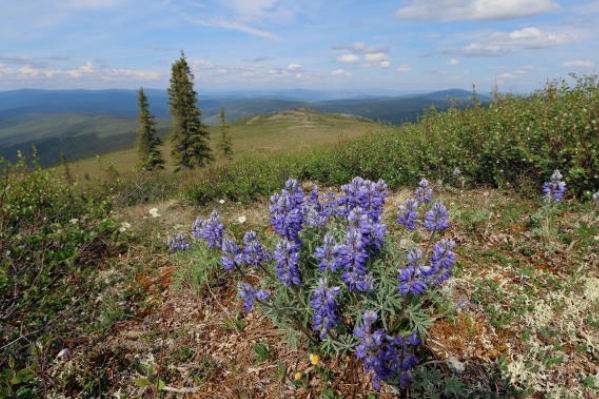
Alaska’s vast wilderness offers a unique wildflower experience.
The state’s diverse landscapes, from alpine meadows to tundra, host a wide variety of wildflowers.
These bloom in the short but intense summer season.
Hatcher Pass, Talkeetna Mountains
Hatcher Pass, in the Talkeetna Mountains, is a paradise for wildflower lovers.
It’s famous for arctic alpine flowers that grow in the harsh, rocky terrain.
Hikers can explore meadows filled with colorful blooms like lupine, gentian, and alpine forget-me-not.
Arctic Alpine Flowers
The arctic alpine flowers in Hatcher Pass are truly stunning.
These plants have adapted to Alaska’s extreme conditions.
They produce vibrant blooms that brighten the rugged landscape.
Savage Alpine Trail, Denali National Park
The Savage Alpine Trail in Denali National Park offers a unique wildflower experience.
This trail winds through various landscapes, including alpine meadows and rocky ridges.
Here, hikers can see the midnight sun blooms.
The 24-hour daylight in summer leads to vibrant wildflower displays.
Midnight Sun Blooms
The midnight sun in Alaska’s summer months causes plants to bloom profusely.
The constant daylight allows for more photosynthesis.
This results in more vigorous growth and blooming, making Alaska’s wildflower displays spectacular.
Alaska’s wildflower hikes are more than just seeing flowers. They offer a chance to explore America’s largest state’s vast, untouched wilderness.
Whether hiking in Hatcher Pass or Denali National Park, visitors have a unique and unforgettable experience.
Comparative Guide to Wildflower Hikes Across Regions
For those who love the outdoors, a guide to wildflower hikes is key.
It helps you find the best spots to enjoy nature.
This guide compares hikes across America, focusing on what matters most to hikers.
Difficulty Ratings and Trail Lengths
Wildflower hikes differ in how hard they are and how long they are.
Some, like the Dog Mountain Trail in Washington, are tough with steep climbs.
Others, like the Antelope Valley California Poppy Reserve, are easier and more relaxed.
| Trail Name | Difficulty | Length (miles) |
|---|---|---|
| Dog Mountain Trail | Challenging | 6.5 |
| Antelope Valley California Poppy Reserve | Easy | 1.5 |
| Skyline Trail, Mount Rainier | Moderate | 5.5 |
Peak Blooming Seasons by Region
The best time to see wildflowers changes with the region.
In the Southwest, Anza-Borrego Desert State Park blooms from February to April.
In the Rocky Mountains, the peak is in July and August.
Accessibility and Facilities
It’s important to have easy access and good facilities for a great hike.
Many wildflower spots have parking, restrooms, and picnic areas.
Family-Friendly Options
For families, the Point Reyes National Seashore Trails in California are perfect.
They have paths for strollers and educational programs, making them great for family trips.
Lesser-Known Wildflower Gems Worth Discovering
The United States has many secret wildflower spots.
These places are full of beauty and offer a quiet outdoor experience.
They are perfect for those who love nature and want to avoid the crowds.
Carrizo Plain National Monument, California
Carrizo Plain National Monument in California is vast and untouched.
It comes alive with color in the spring. You’ll see California poppies, lupine, and goldfields here.
Its rolling hills and wide views make it a dream for photographers.
It’s a great place to see California’s wildflowers up close.
Roan Mountain, Tennessee/North Carolina
Roan Mountain lies on the border of Tennessee and North Carolina.
It’s famous for its vibrant rhododendron gardens. The gardens turn pink and purple in mid-to-late June.
Rhododendron Gardens
The rhododendron gardens on Roan Mountain are a must-see.
They bloom in mid-to-late June. This event draws visitors from all over, showing off the beauty of the Appalachian Mountains.
Organ Mountains-Desert Peaks National Monument, New Mexico
Organ Mountains-Desert Peaks National Monument in New Mexico is a hidden gem.
It has desert and mountain areas, supporting many plants.
You can see desert marigold, Mexican gold poppy, and even the Stanleya pinnata, or desert prince’s plume.
These places let you enjoy nature’s beauty in a peaceful way.
Whether you love hiking or just want a unique outdoor adventure, these spots are worth exploring.
Wildflower Identification Guide for Hikers
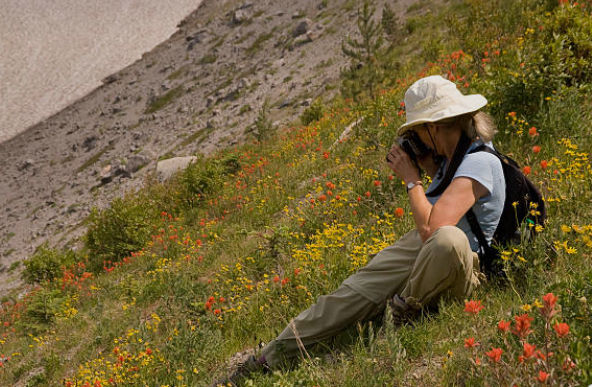
Learning to identify wildflowers makes hiking more enjoyable. It lets you see the beauty around you.
With so many species in America, it’s both fun and challenging.
Common Wildflower Species by Region
Each part of the United States has its own wildflowers.
In the Pacific Northwest, look for Western Buttercups and Nootka Roses.
The Southwest boasts Desert Marigolds and Globemallows.
- Lupines in the Rocky Mountains
- Black-eyed Susans in the Midwest Prairies
- California Poppies along the California coast
Endangered Wildflower Species to Know
Some wildflowers are at risk due to habitat loss.
Hikers should know about endangered species like California’s Marin Dwarf Manzanita and Texas’ Hinckley’s Oak Fern.
It’s important to protect their habitats.
Recommended Field Guides and Mobile Apps
For accurate identification, use field guides and mobile apps.
Peterson Field Guides and Newcomb’s Wildflower Guide are great.
Apps like PlantSnap and FlowerChecker help with quick photo searches.
Digital vs. Print Resources
Both digital and print resources have benefits. Print guides are hands-on and don’t need batteries. Mobile apps are quick and always updated. Many hikers use both for the best results.
Conclusion
America’s wildflowers paint the country with a colorful palette.
They show off the diverse beauty of the land.
From the Pacific Northwest to the Southwest deserts, each area has its own wildflowers and trails.
Going on these wildflower hikes lets us see America’s natural beauty up close.
It also helps us appreciate the environment and the need to protect it.
Knowing when to go, planning, and viewing responsibly are key to keeping these wonders alive.
Wildflowers across America offer a wide range of experiences.
From California’s Antelope Valley to Alaska’s Hatcher Pass, each place has its beauty.
Caring for these flowers, we make sure future generations can enjoy their beauty too.
FAQ
What are the best months to see wildflowers in the USA?
The best months to see wildflowers change by region. Spring (March to May) and early summer (June to July) are usually the best. For example, the Pacific Northwest blooms in late spring. The Southwest deserts bloom after rain, often in late winter or early spring.
How can I predict wildflower blooms?
To predict wildflower blooms, check the USA National Phenology Network, Wildflower Search, or the National Park Service’s updates. These sources give bloom forecasts, trail conditions, and peak viewing times.
What should I bring on a wildflower hike?
Bring essentials like water, sun protection, and comfy hiking shoes. Don’t forget a camera. It’s smart to bring a field guide or app to identify wildflowers. Also, a map and compass or GPS are useful.
How can I photograph wildflowers effectively?
Use a macro lens or extension tubes for details. Shoot during the golden hour for soft light. A tripod and polarizing filter can help stabilize your camera and reduce glare.
What are some family-friendly wildflower hikes?
Family-friendly hikes are in national parks and monuments. The Antelope Valley California Poppy Reserve has short, easy trails. The Craggy Gardens Trail in North Carolina has a paved path and scenic views.
How can I help conserve wildflowers?
Follow Leave No Trace principles, stay on trails, and avoid damaging plants. Donate to organizations that protect wildflower habitats. Spread the word about preserving these natural areas.
What are some endangered wildflower species I should know about?
Endangered species include the California’s Marin Dwarf Flax, the Texas Wildrice, and the Virginia Spiderwort. Be mindful of these when hiking. Report any sightings to local conservation authorities.
Can I hike with my dog on wildflower trails?
It depends on the trail and location. Some trails allow dogs, others don’t. Always check trail rules before bringing your dog. Clean up after them to prevent invasive species and keep the area clean.

